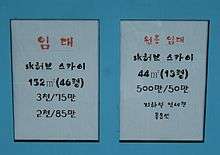Pyeong
A pyeong (abbreviation py) is a Korean unit of area and floorspace, equal to a square kan or 36 square Korean feet. The ping and tsubo are its equivalent Chinese and Japanese units, similarly based on a square bu (ja:步) or ken, equivalent to 36 square Chinese or Japanese feet.[1][2]
| Pyeong | |||||||||||||
|---|---|---|---|---|---|---|---|---|---|---|---|---|---|
 Listing outside a Korean real-estate agency showing floorspace in square meters and pyeong | |||||||||||||
| Chinese name | |||||||||||||
| Chinese | 坪 | ||||||||||||
| |||||||||||||
| Korean name | |||||||||||||
| Hangul | 평 | ||||||||||||
| Hanja | 坪 | ||||||||||||
| |||||||||||||
| Japanese name | |||||||||||||
| Kanji | 坪 | ||||||||||||
| Kana | つぼ | ||||||||||||
| |||||||||||||
Pyeong
In Korea, the period of Japanese occupation produced a pyeong of 400/121 or 3.3058 m2. It is the standard traditional measure for real estate floorspace, with an average house reckoned as about 25 pyeong, a studio apartment as 8–12 py, and a garret as 1½ py. In South Korea, the unit has been officially banned since 1961 but with little effect prior to the criminalization of its commercial use effective 1 July 2007.[3] Informal use continues, however, including in the form of real estate use of unusual fractions of meters equivalent to unit amounts of pyeong.
Ping
In Taiwan, the Taiwanese ping remains in fairly common use and is about 3.306 m2. In mainland China, the metrification of traditional units would produce a ping of 4 m2, but it is almost unknown with most real estate floorspace simply reckoned in square meters. The longer length of the Hong Kong foot produces a larger ping of almost 5 m2, but it is similarly uncommon.
Tsubo
In Japan, the usual measure of real estate floorspace is the tatami and the tsubo is reckoned as two tatami. The tatami varies by region but the modern standard is usually taken to be the Nagoya tatami of about 1.653 m2, producing a tsubo of 3.306 m2. It is sometimes reckoned as comprising 10 gō.
See also
References
- "Unit conversion chart". Web.archive.org. 28 December 2005. Archived from the original on 28 December 2005. Retrieved 25 August 2017.CS1 maint: BOT: original-url status unknown (link)
- "ko:'평' : 네이버 국어사전". Krdic.naver.com. Retrieved 25 August 2017.
- "Gov't to Crack Down on Those Referring to Land as 'Pyeong'", The Hankyoreh, Seoul: Hankyoreh Media, 23 June 2007.